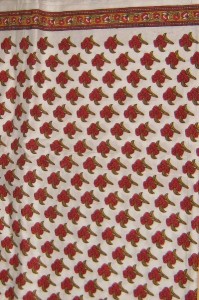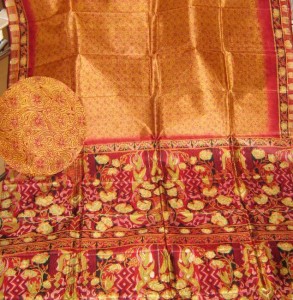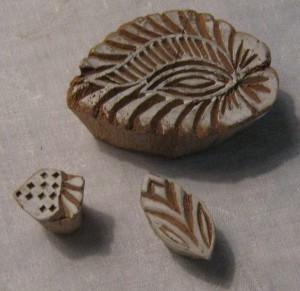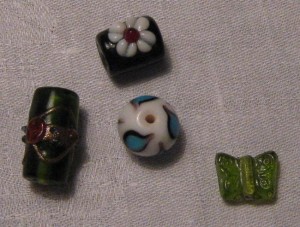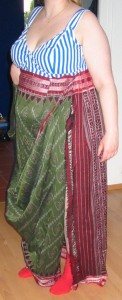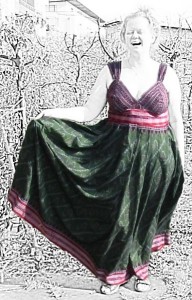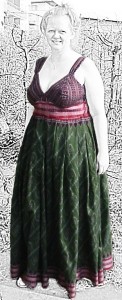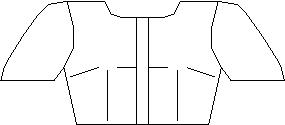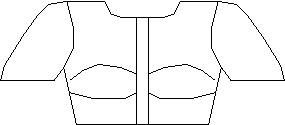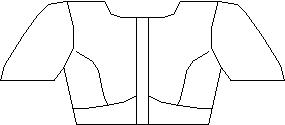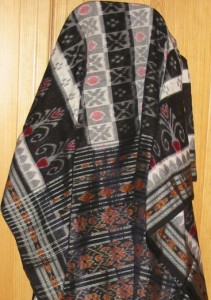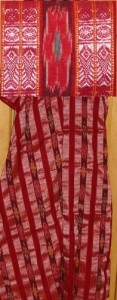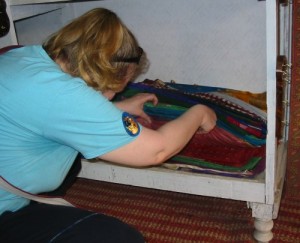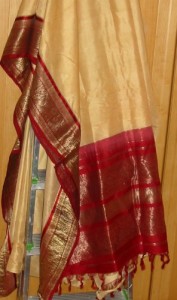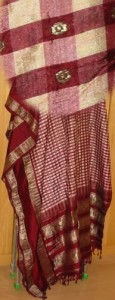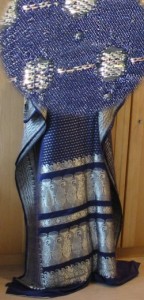Textile Stuff from India, part 3
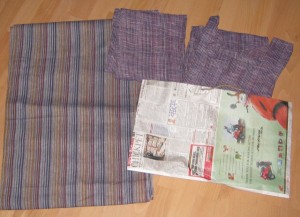 Hm, also beim Einkaufen kam mir das viel weniger vor, als jetzt wo ich es poste…. *hüstel*
Hm, also beim Einkaufen kam mir das viel weniger vor, als jetzt wo ich es poste…. *hüstel*
Somehow it did not look that much, when I was shopping for it. But now I’m posting about it… must have multiplied somehow..
Zwei weitere schöne Khadi Stoffe sind in meinem Koffer gelandet. (Die Kahdi Bewegung entstand als Protest gegen die Kolonialmächte und propagierte, man solle nur indische Produkte verwenden, die jeder Haushalt selber herstellen konnte. Ganz so entschieden wird es nicht praktiziert, aber es handelt sich um handgesponnene und hangewobene Materialien, die so der Dorfbevölkerung eines zusätzliche Einnahmequelle verschaffen. Meist sind es Baumwollgewebe, die auch etwas gröber und rauher sind, als maschinell gewebte.) Mir gefällt speziell diese etwas “griffigere” Struktur zusammen mit dem Webmuster.
Next are two Khadi fabrics. (Khadi Movement started as a protest against the colonial forces. The idea was using only India made material and produce everything in India, so every household could make it’s own clothes and didn’t have to buy imported goods. It isn’t done so strictly, but it is hand spun and hand woven material and provides some additional income for farmers. Material is often cotton and the fabric is coarser than machine woven one.) And this coarser structure is exactly what I like about it, together with the woven pattern.
Und weil ich ja weiß, wie ich mit Nähen hinterher komme, habe ich einen davon bei meiner Freundin in die Waschmaschine geworfen und gleich zu einer Kurta verarbeiten lassen. 🙂 Was mich weniger als 2 EUR kostete. (Und das war schon bei einer gutsituierten Designerin in Bangalore, nicht der Dorfschneider.) Faszinierend finde ich auch die Tüte, in der ich meine Tunika bekam: Aus einer alten Zeitung sorgsam gefaltet und geklammert. So einfach kann Recycling sein.
And since I know how not fast I am sewing I threw one of the fabrics in my friends washing machine and had her tailor making me a kurta. 🙂 Which did cost me less than 2 EUR. (And that was already a well to do designer in Bangalore, not a tailor at some remote village.) And I was fascinated by the bag I got my tunic in. Folded and stapled from an old newspaper. Recycling can be so easy.
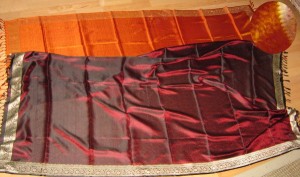 Und jetzt kommt die echte Handwerkskunst… Banarasi Silk. Seide aus Varanasi. An Jacquard Webstühlen von Hand gewoben in ganz feinen Mustern. Die Vergrößerung rechts im Bild versucht es einzufangen, aber die Kamera hatte Probleme, das scharf zu stellen.
Und jetzt kommt die echte Handwerkskunst… Banarasi Silk. Seide aus Varanasi. An Jacquard Webstühlen von Hand gewoben in ganz feinen Mustern. Die Vergrößerung rechts im Bild versucht es einzufangen, aber die Kamera hatte Probleme, das scharf zu stellen.
And now for the real artful craft… Banarasi Silk. Silk from Varanasi. Hand Woven on Jacquard looms with the finest pattern. I tried to catch it in the zoomed part on the right, but my camera had problems to focus on it.
Typischerweise werden Metallicfäden mit der Seide kombiniert, aber es gibt sie auch Ton in Ton changierend, wie diese beiden Schals. (Wobei einer davon ein Geschenk wird… so gierig bin ich dann auch nicht.
Typically metallic thread is combined with silk to make the pattern, but they also make the weaves in hues that make the shawl look as if it could change color. (One of those is not for me but a gift, I am not that greedy…)
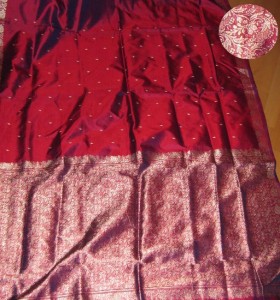 Natürlich mußte auch einer der Saris mit. (Diesmal zeigt die Vergrößerung auch mehr von der feinen Arbeit.) Prächtig dekoriert ist nur der Pallu, der Rest ist dezenter. Was man auf dem Bild auch nicht sieht, ist die changierende Grundfarbe. Kette und Schuß sind in verschiedenen Farben und je nach Blickrichtung ist der Sari eher rot oder eindeutig lila.
Natürlich mußte auch einer der Saris mit. (Diesmal zeigt die Vergrößerung auch mehr von der feinen Arbeit.) Prächtig dekoriert ist nur der Pallu, der Rest ist dezenter. Was man auf dem Bild auch nicht sieht, ist die changierende Grundfarbe. Kette und Schuß sind in verschiedenen Farben und je nach Blickrichtung ist der Sari eher rot oder eindeutig lila.
Of course I could not leave without one of the sarees. (Here the zoom show more of the detailed pattern.) Heavily decorated is only the pallu, the rest is only slightly patterned. What the picture can not show is the ability to change to color of the basic fabric. Warp and weft have different colors and depending on how you look on it it is quite red or more purple.
Je stärker gemustert ein Teil ist, desto teurer wird es, denn es steckt mehr Arbeit drin. Wir haben auch große Tagesdecken gesehen, die durchgehend so dicht gemustert sind und in vielen Farben, daran arbeiten dann vier Männer über drei Monate. Da ich die Fabrik besichtigen konnte habe ich auch gesehen, daß immer wenigstens zwei Männer an einem Webstuhl arbeiten, um diese Muster zu gestalten.
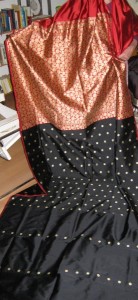 Here the rule is the more heavily patterned the more expensive it gets because there is really a lot of work put into it. We were also shown a huge bedspread which had a dense all over pattern in many colors. That means for men are working on it for three month. We were allowed to visit the production site also, so I could see that there are at least two men working on one loom to create those pattern.
Here the rule is the more heavily patterned the more expensive it gets because there is really a lot of work put into it. We were also shown a huge bedspread which had a dense all over pattern in many colors. That means for men are working on it for three month. We were allowed to visit the production site also, so I could see that there are at least two men working on one loom to create those pattern.
Und zum Abschluß noch ein untypisches Muster. Hier ist das Material etwas fester und steifer (ebenfalls untypisch für Banarasi Silk) und ich konnte mir spontan ein Kostüm oder ein Etuikleid daraus vorstellen, das mit den unterschiedlichen Mustern spielt. Ganz oben erkennt man auch einen einfarbigen Teil, das ist das “blouse piece”, aus dem man das Oberteil zum Sari nähen würde. Mal sehen, ob und wann ich dazu komme, das zu verarbeiten. 🙂
To finish an atypical saree pattern. Here also the structure a less soft and a bit stiffer (also atypical for Banarasi silk) and I could imagine spontaneously a skirt-jacket combination or a simple sheath dress from it, playing with the different pattern. On top you can see a bit of a plain weave in red, that is the “blouse piece” where you would have your tailor to make the top from. Well, let’s when I will find the time to make something of it. 🙂

